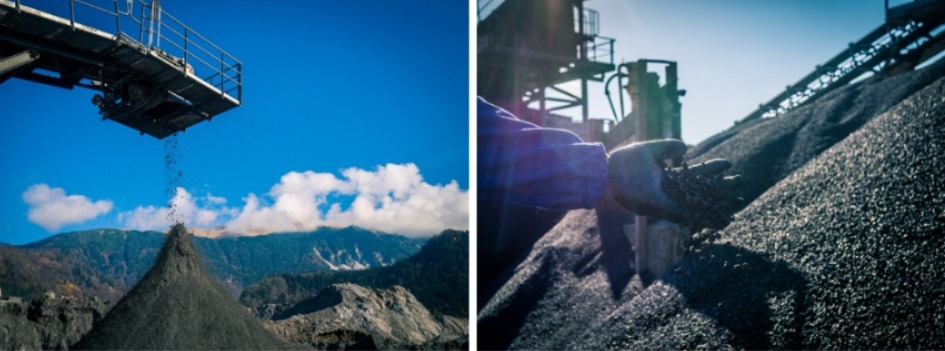

1 . Introduction
In the field of civil engineering, there is a growing focus on utilising alternative materials in construction practices due to the rising demand for raw materials. The infrastructure sector is increasingly investing in research on waste materials to repurpose them for road construction. Materials salvaged from demolished buildings play a crucial role in reducing reliance on new raw materials and minimising environmental impact. Road pavement construction traditionally consumes substantial energy and non-renewable resources.
Consequently, there has been a notable shift towards developing sustainable solutions, emphasising the use of recycled and/or reused materials in recent decades. The most commonly recycled materials originate from waste produced by the steel and demolition industries. These materials, such as reclaimed asphalt pavement, steel slag, and ceramics, can replace virgin mineral aggregates in asphalt mixtures at different percentages. Steel furnace slag is widely utilised and renowned as a superior asphalt aggregate among the materials examined.
This by-product of the steel-making process, iron and steel slag, is commonly employed as an aggregate in asphalt pavements. It is comprised mainly of silica, alumina, titanium, iron sand, and various combinations of magnesium and calcium oxides, serving to regulate the temperature of molten iron during steel production. Steel slag is classified into three types: ladle furnace slag (LF), electric arc furnace slag (EAF), and basic oxygen furnace slag (BOF).
BOF slag has been increasingly integrated into warm-mix asphalt, porous asphalt, hot-mix asphalt, stone-mastic asphalt, and dense-graded asphalt concrete (DGAC-BOF), and has also been utilised as the main component in hydraulic road binders in recent decades. Research findings have highlighted the steel slag’s exceptional resistance to moisture-induced damage and permanent deformation in asphalt mixtures. The presence of angular and rough-textured particles in steel slag enhances the interlocking mechanism, thereby imparting robust mechanical properties.
Steel slags produced from EAFs, predominantly in Italy, are extensively utilised in concrete mixtures for various construction projects. Research has also explored their application in road pavements. Granulated EAF slag can replace natural aggregates up to 15 percent, under specific conditions. In 2017, a group of researchers from Spain conducted a comprehensive review and analysis of various recycling techniques. They suggest that after suitable pre-treatment, EAF slag can substitute some coarse aggregates in different types of asphalt mixtures, thereby enhancing durability, sustainability, and mechanical performance as compared to the conventional mixtures.
In addition, Ladle furnace (LF) slag (white) finds its primary application in improving soil stabilisation. It can also be directly used in concrete mixtures for rural roads with low traffic volume or as a filler in asphalt mixtures. This material is refined either in a LF or specialised converters designed for high-alloy steel.
2 . Production
Approximately one ton of steel slag is generated for every three tons of stainless steel produced. Globally, the steel industries produce around 50 million tons of steel slag annually, with Europe alone producing about twelve million tons each year. Steel slag is a by-product of stainless steel production, which can be derived from converting iron to steel in a BOF or melting scrap metal in an EAF. In a basic oxygen furnace, the process involves hot liquid metal, scrap, fluxes, lime, and dolomite lime.
Steel slag forms as impurities such as carbon monoxide, silicon, manganese, phosphorus, and iron are separated in a liquid state by injecting high-pressure oxygen, separating from lime and dolomite lime. In contrast, the electric arc furnace processes cold steel scrap in a kettle-shaped furnace, melting it with a strong electric current flowing through graphite electrodes. Ferro alloys and oxygen are added to balance the steel’s chemical composition, with the molten steel’s surface separated from the floating steel slag.
The resulting steel slag is crushed to approximately eight inches by dropping a large steel ball or solid steel cylinder onto it, a process repeated until the aggregates reach the desired grade. At the same facility, metallic particles are electromagnetically recovered using conveyor belts and processed into construction aggregate. Given the limited availability of high-performance aggregates, steel slag competes with natural aggregates. This underscores the importance of utilising alternative aggregates like steel slag, which are valuable products rather than waste and contribute positively to the environment.
3. Properties
The performance and suitability of steel slag aggregates are determined by their unique properties. Factors such as durability, permeability, stability, resistance to abrasion, cracking, and permanent deformation are influenced by the mechanical and physical characteristics of the aggregate. Additionally, the chemical composition of steel slag aggregates plays a crucial role in their ability to bond effectively with other construction materials, ensuring optimal performance.
Steel slag from EAF meets the requirements for aggregates used in asphalt mixtures and surface treatments, making it suitable for use in roads, airports, and other pavement applications due to its satisfactory durability, physical, and mechanical properties. Steel slag aggregates typically exhibit angular shapes, rough surface textures, low water absorption rates (typically less than 3 percent), and high bulk specific gravity.
The chemical composition of slag is often analysed in terms of simple oxides using x-ray fluorescence, with its mineralogical structure influenced by the rate of cooling during the steel-making process. Steel slag demonstrates neutralisation capacity, with maximum effectiveness at pH levels above 8.5 and reduced capacity in weakly alkaline or neutral pH environments. It exhibits low water solubility and negligible gas release when in contact with water, although it may show an alkali reaction (pH between 11.09 and 12.27).
To assess the suitability of steel slag for asphalt mixtures, EAF steel slag underwent mechanical testing to evaluate its mechanical, geometric, and physical properties. The results of these experiments were compared with those of conventional aggregates commonly used in asphalt production. Processed steel slag exhibits higher bearing strength, superior abrasion resistance, suitable mechanical properties, and good soundness characteristics compared to natural aggregates.
4. Application
Steel slag has proven successful in various road construction applications, including wearing course, road base and sub-base. It has been effectively utilised as aggregate in flexible pavement surfacing and bases, particularly in Europe, Canada, Australia, and the United States, where it is recognised not only as an industrial waste, but also as a valuable construction material. Steel slag has an ability to provide high skid resistance throughout the pavement’s service life, underscoring one of the key advantages of using steel slag in asphalt mixtures.
In asphalt surface mixtures, the use of steel slag aggregate results in pavements with excellent skid resistance, as evidenced by skid resistance numbers measured using American Society of Testing and Materials (ASTM E274) standards. The exceptional stability of asphalt mixtures containing steel slag aggregate can improve permanent deformation (or rutting resistance) on surface layers. Mixtures incorporating natural sand and steel slag aggregate have shown significantly high stiffness modulus values. High stiffness values are indicative of potential for thinner pavement layers, compensating for the higher density challenges typically associated with asphalt mixtures containing steel slag.
Using EAF steel slag instead of natural aggregates has been identified as a more cost-effective option for constructing low-volume roads. Research has investigated the use of appropriately weathered EAF steel slag as a base material for low-volume road construction. Resilient modulus tests have indicated that EAF steel slag performs satisfactorily compared to natural aggregates. Research indicates that incorporating 30 to 85 percent steel slag by weight into a mixture of marl and sand achieved the California Bearing Ratio (CBR) values up to 455 percent for road base applications. Additionally, the properties of cement-stabilised steel slag have been studied for use in base and sub-base courses, demonstrating superior performance compared to cement stabilisation using natural aggregates.
5. Challenges
One significant concern regarding the use of steel slag as aggregates in highway engineering is its potential for volume instability. The mineral constituents within steel slag affect its cooling rate, which, when exposed to water in a humid environment, can lead to reactions involving free lime (CaO) and free periclase (MgO). These compounds undergo hydration to form portlandite (Ca(OH)₂) and brucite (Mg(OH)₂), causing significant expansion primarily due to these hydrates. This expansion can weaken and disintegrate the slag, rendering it unsuitable for use as compacted fill material or in Portland cement concrete. Earlier in 1989, Verhasselt and Choquet from Belgian Road Research Centre, Belgium extensively discussed the use of steel slag as unbound aggregate in highway construction, noting that the presence of free lime, which expands the material by nearly 100 percent upon transformation into portlandite, contributes significantly to its instability.
In 2014, Oluwasola and associates from Universiti Teknologi Malaysia found another challenge associated with using steel slag in road and highway construction. The formation of Tufa-like deposits occur due to exposure of the aggregates to water and air. Tufa is a white, powdery precipitate primarily composed of calcium carbonate. This calcium carbonate precipitates from surface water as tufa and powdery sediment when the calcium hydroxide solution, formed by the reaction of free lime in steel slag with water, encounters atmospheric conditions. Tufa deposits can potentially clog highway drainage systems, as noted previously by Hamilton and associated from USA in 2007.
Additionally, the lack of standardised guidelines or specifications for the use of steel slag in road construction globally poses another challenge. This underscores the need for caution when utilising steel slag, emphasising the necessity for developing and adhering to specific standards and specifications for its application in highway construction.
6. Conclusions
In modern highway construction, there is a growing interest in using synthetic or recycled materials. Steel slag emerges as a promising alternative to natural aggregates for road building, offering superior durability while also promoting environmental sustainability. Steel slag aggregates demonstrate significant advantages in asphalt mixtures, outperforming many natural aggregates in terms of resistance to pavement rutting, fatigue, and stiffness. However, there are currently no standardised guidelines for blending steel slag with natural aggregates to achieve optimal mix designs. Despite limited research in this area, literature suggests that steel slag shows promising potential for use in subgrade or embankment applications.
Due to its distinct chemical and mineralogical composition, steel slag differs from natural aggregates, necessitating specialised guidelines rather than relying on those intended for natural materials. Although transportation costs may pose a challenge, particularly for rural roads, the use of steel slag could prove more cost-effective and sustainable on urban roads.
Authors :

Nur Amirah Najihah Binti Shahminan
Masters Students, Department of Civil Engineering
Universiti Kebangsaan Malaysia (UKM), Selangor.

Dr. Ahmad Yusri Bin Mohamad
Lecturer, Department of Civil Engineering
Politeknik Sultan Haji Ahmad Shah (POLISAS), Pahang

Assoc. Prof. Ts. Ir. Dr. Nur Izzi Bin Md Yusoff
Senior Lecturer, Department of Civil Engineering
Universiti Kebangsaan Malaysia (UKM), Selangor.